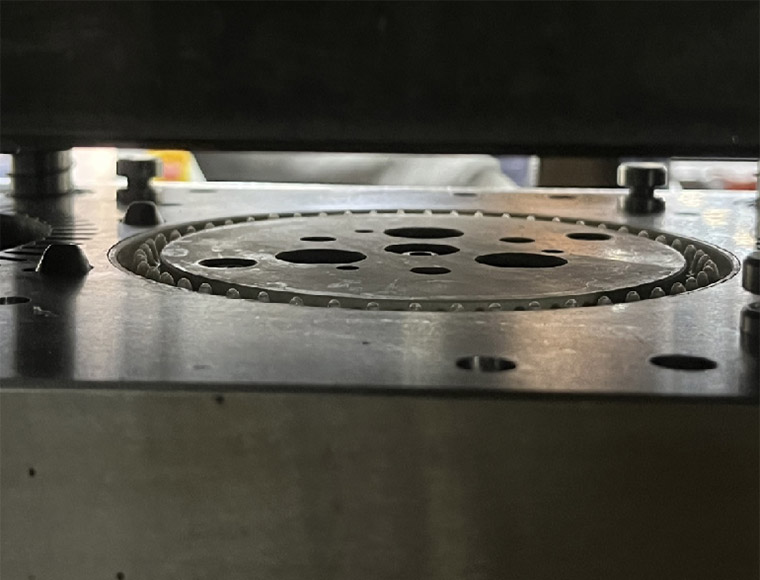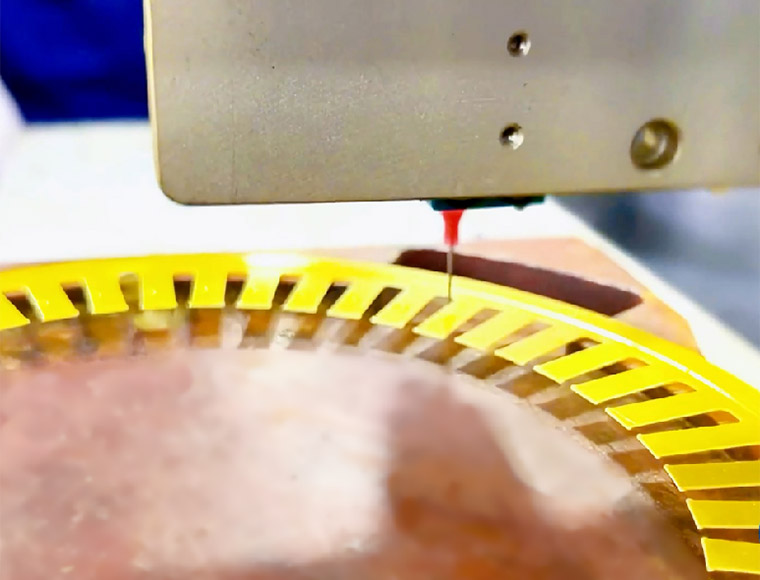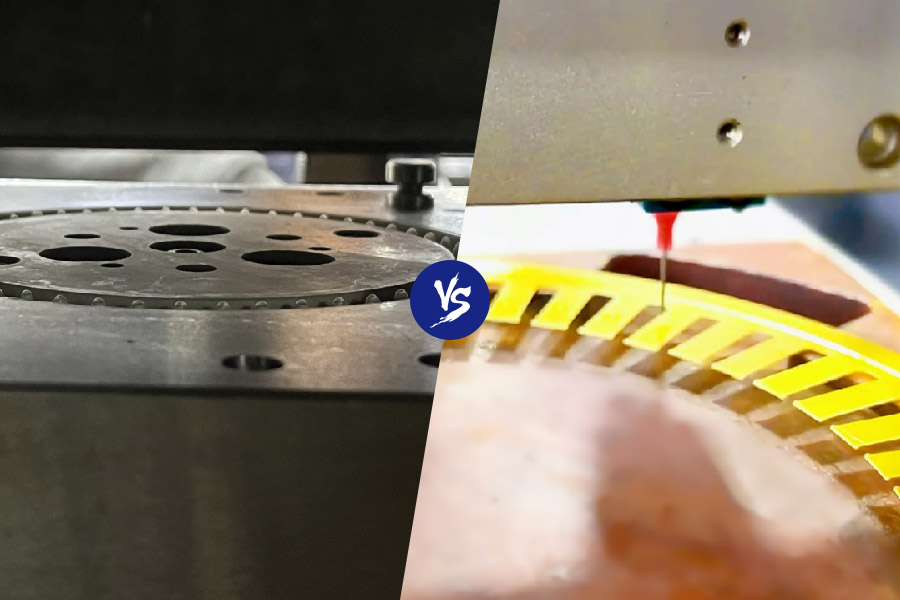Deciding between in-mold and out-mold glue dispensing is a significant choice in the production of stator and rotor stacks. Each method has its own advantages, with their suitability relying on the particular requirements of the application. Understanding the strengths, processes, and applications of each approach is essential for achieving optimal manufacturing outcomes.
The Role of Glue Dispensing in Manufacturing
Glue dispensing is a critical step in securing laminations within the stator and rotor stacks. It ensures structural integrity, reduces vibration, and improves overall motor efficiency. The choice between in-mold and out-mold glue dispensing affects not only the performance of the final product but also the efficiency and scalability of the manufacturing process.

In-Mold Glue Dispensing
In-mold glue dispensing is a high-performance method where the adhesive is applied directly within the mold during the lamination stacking process. The glue reacts with a catalyst and cures within 10-20 seconds. After multiple stampings, a hydraulic top cylinder and locking ring finalize the stack’s shape and structural integrity.
Key Advantages of In-Mold Dispensing:
High Inter-Sheet Strength:
- Reduces sheet spacing from 5-10μm to 2-3μm.
- Achieves riveting strength between sheets of ≥1000N, ensuring superior durability.
Beautiful Product Shape:
- Prevents deformation of the product’s appearance.
- Reduces vibration and noise, leaving no buckle points, welding marks, or rivet impressions.
Excellent Performance Parameters:
- Enhances magnetic flux density, improving energy efficiency.
- Reduces iron loss by 10%, contributing to better motor performance.

Out-Mold Glue Dispensing
Out-mold glue dispensing involves applying adhesive to laminations after they are removed from the mold. A visual automatic positioning system, combined with a jet valve syringe dispensing head, ensures precise application. This method supports tilting and 360-degree rotation for even adhesive distribution on complex geometries.
Key Advantages of Out-Mold Dispensing:
Precision and Control:
- Visual systems ensure accurate alignment and adhesive positioning.
- Advanced fluid control software guarantees stable and consistent application.
Flexibility:
- Accommodates various stack sizes and intricate designs.
- Supports customization for unique production requirements.
Adaptability for Complex Shapes:
- Ideal for prototypes and small-batch production.
- Handles irregular shapes and non-standard configurations effectively.
Comparing In-Mold and Out-Mold Dispensing
1. Strength and Bonding:
In-mold dispensing offers superior inter-sheet strength and structural stability, making it the preferred choice for high-performance applications. Out-mold dispensing, while precise, does not match the bonding strength of in-mold methods.
2. Product Appearance and Noise Reduction:
In-mold dispensing prevents deformation and leaves no visible marks, ensuring a flawless finish and reduced noise. Out-mold dispensing may result in minor imperfections during adhesive application.
3. Flexibility and Customization:
Out-mold dispensing excels in handling intricate designs and small-batch production, while in-mold methods are optimized for standardized, high-volume manufacturing.
4. Efficiency and Speed:
In-mold systems integrate adhesive application and stamping, significantly reducing production time. Out-mold methods, requiring separate adhesive application, are slower by comparison.
5. Cost Considerations:
In-mold dispensing involves greater upfront costs but delivers long-term savings by enhancing efficiency and minimizing waste. On the other hand, out-mold dispensing is initially cheaper but may result in higher ongoing operational expenses.
Key Considerations When Selecting a Method
Manufacturers need to assess various factors to identify the most suitable dispensing method for their requirements.
- Production Volume: High-volume production benefits from the speed and efficiency of in-mold dispensing, while out-mold methods are ideal for low-volume or customized applications.
- Design Complexity: Simple, standardized designs align well with in-mold dispensing, whereas intricate configurations require the flexibility of out-mold systems.
- Quality Requirements: For superior strength, performance, and appearance, in-mold dispensing is the preferred choice.
- Budget and Scalability: Consideration of initial costs versus long-term savings is essential in selecting the appropriate method.
Industry Trends and Innovations
Advances in adhesive technology and automation are bridging the gap between in-mold and out-mold dispensing. Hybrid systems, combining the strengths of both methods, are emerging as versatile solutions for diverse manufacturing needs. Industries such as automotive, renewable energy, and robotics are driving demand for innovative glue dispensing technologies that enhance precision, efficiency, and sustainability.
Case Studies: Applications of In-Mold and Out-Mold Dispensing
In-Mold Success:
Automotive manufacturers have adopted in-mold dispensing to produce high-performance stator and rotor stacks with exceptional strength and energy efficiency. The process’s ability to deliver flawless products at scale has made it a cornerstone in the production of electric vehicles.
Out-Mold Success:
Prototyping facilities and small-scale manufacturers frequently rely on out-mold dispensing for its adaptability. The method’s precision and customization capabilities allow for rapid development of innovative designs without the need for extensive tooling modifications.
Conclusion
In-mold and out-mold glue dispensing methods each bring unique strengths to the production of stator and rotor stacks. In-mold dispensing stands out for its superior bonding strength, aesthetic finish, and efficiency, making it ideal for high-volume, standardized production. Out-mold dispensing, with its precision and adaptability, is better suited for custom designs and smaller production runs.



